by Mark Freburg
Prior to the late 1980s, Colt was the only real name in 1911 pistols. In 1974, Springfield Armory bought and paid for the rights to use the same name as the closed-since-1968 U.S. government armory and began building M1911A1s (and rifles) from surplus and other parts, eventually using 1911 slides and frames from Imbel of Brazil. Imbel is the maker of Springfield pistols to this day. (Update: Shortly after we published this I saw a report that Springfield began making their pistols in the US a couple years ago, whether from Imbel parts or US-sourced parts, it wasn't said, and Springfield's website doesn't say either.) These were straight-up GI-style M1911A1s, about the same as the Colt 1911s offered in those days . There had been other makers of 1911 pistols, some of good quality, such as Randall (known for making a mirror image left-hand 1911), but no maker prospered enough to stay in the marketplace during the 20th Century other than Colt until Springfield Armory gained a foothold. Some may recall Detonics, but the Detonics of those days were were slightly modified from original 1911s, not M1911 clones. (Detonics firms that arose after bankruptcy did make true to the design 1911s but this occurred later). Other names of the era lacked quality, such as Essex. Names you may remember from the later 20th Century, like Ed Brown and Bill Wilson, made their names strictly as custom pistolsmiths and never offered production pistols until the 21st Century. The bottom line is in fact that Colt ruled the roost for at least seventy years however you wish to look at it, fending off all comers.
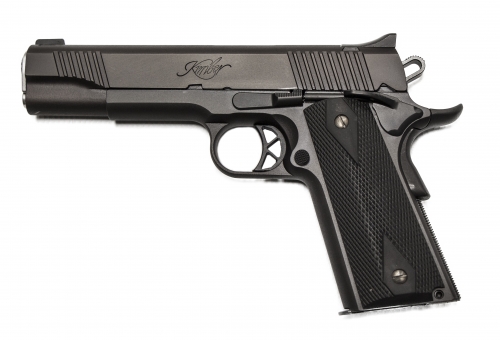 While Springfield finally came to challenge Colt's control of the market late in the last century, it was still the GI pistol. It was Kimber that changed the way we think of, and buy 1911s today. For those of us who buy and shoot, keep, carry, collect, compete with and simply own--or want to own 1911 pistols, the world has changed since the first Kimber Custom hit the market in 1997. I must repeat that the basic Colt Government and Commander model pistols were all strictly GI style in those days, and so were the pistols from Springfield Armory and others. Suddenly, here was Kimber, a company that made its name selling rifles in Oregon, then was sold, moved to New York, and suddenly started selling a factory 1911 pistol with combat sights, and extended thumb safety, a beavertail, and so on--the features we had all been paying gunsmiths to add to our GI-spec 1911s. It was a big deal. Kimber made it painless as well as faster to buy a "factory custom" 1911. Others followed Kimber of course, Springfield Armory had similarly-equipped 1911s on the streets within a year or two, and those two giants continue to slug it out for the 1911 market to this day, along with Colt and seemingly a hundred others.
While Springfield finally came to challenge Colt's control of the market late in the last century, it was still the GI pistol. It was Kimber that changed the way we think of, and buy 1911s today. For those of us who buy and shoot, keep, carry, collect, compete with and simply own--or want to own 1911 pistols, the world has changed since the first Kimber Custom hit the market in 1997. I must repeat that the basic Colt Government and Commander model pistols were all strictly GI style in those days, and so were the pistols from Springfield Armory and others. Suddenly, here was Kimber, a company that made its name selling rifles in Oregon, then was sold, moved to New York, and suddenly started selling a factory 1911 pistol with combat sights, and extended thumb safety, a beavertail, and so on--the features we had all been paying gunsmiths to add to our GI-spec 1911s. It was a big deal. Kimber made it painless as well as faster to buy a "factory custom" 1911. Others followed Kimber of course, Springfield Armory had similarly-equipped 1911s on the streets within a year or two, and those two giants continue to slug it out for the 1911 market to this day, along with Colt and seemingly a hundred others.
So the 1911 market should be simpler for today's buyer than was yesteryear's, as the pre-Kimber buyer had to have any custom work done after he bought his pistol. Today, if you shop around you can find seemingly any feature you might want in a factory pistol. Is this true? Let's compare 1911 buying then and now.
Customizing was the obvious and required next move for almost all new 1911 buyers; few bought and shot a bare bones Government Model or Commander as is. Colt did offer the Gold Cup which came with adjustable target sights and a special trigger, but it was priced out of reach out for Joe Average. Again, every standard Government Model came only with GI-type features so yes, this customizing was necessary. I have to interrupt myself, actually they were commercial features that had been with us for most of a century and known as commercial Colts, but today's sellers and buyers refer to them as GI-style features, notwithstanding the fact that they were not truly GI. Some parts clearly visible to the naked eye, such as the thumb safety (aka safety lock), as decidedly non-GI. For example, what you think of as a standard (not extended) safety has been with us a very long time and was the standard commercial safety lock--most of today's so-called GI 1911s have this commercial safety instead of the GI style which had no ledge at all but rather a small tab located at the front.
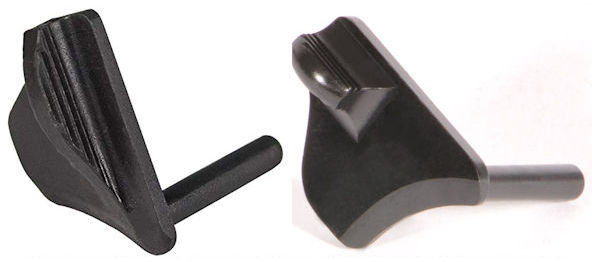
Left, commercial thumb safety, often used on "GI" style 1911s today. Right, original GI safety as used by the US military on all 1911 pistols.
Many if not most people shot their new guns with ball ammo to break them in--because breaking-in was necessary, Colts and all 1911s not being nearly as smooth and refined as they are today--but also to see what features the pistol lacked and what it needed. This was part of the process. Some guys just sent their new gun off to the gunsmith, but that was considered unwise, as the pistol was still going to need breaking-in eventually, and worse, the user was going to have no idea if he needed this feature or that until he tried the basic pistol as-is. Let's consider some various changes that used to be made after the initial purchase.
Sights were an obvious need, but what sights? There were many to choose from even back then. Yes, we have a wider variety of sights available today, but perhaps that isn't automatically a better variety. You might think night sights trump all, or fiber optics, both relatively modern, but have you noticed the growing surge to brass beads, or ivory front sights for defense, perhaps? Neither are new. Or have you noted that many night sight makers have gone to adding white or brightly colored circles around them so they no longer appear to be gray blobs during daylight? Not all night sight-equipped pistols are shot only at night. In fact, I suspect most good citizens almost never shoot them in darkness but always with light, from ambient to full daylight. Night sights for years sucked when shot during daylight. Even today, some more progressive gun manufacturers of other handgun types are making it easier for the end user to change sights. It hasn't happened much with 1911s, other than fiber optics makers offering different colored pipes, but that is just a different shade of crap in my opinion, as I happen to think fiber optics suck worse than night sights. With fiber optics you need full-on light for them to work. And if your eyes don't do well with florescent colors, good luck (mine don't, thus my opinion). With starting from scratch and deciding on the sights you wanted, you never had to remove sights you hated and possibly be stuck with sight cuts in the slide you couldn't use. In those days we had the fabulous BOMAR for target work, among others, and a good variety of fixed sights. Thankfully the Italian maker LPA has essentially cloned the discontinued BOMAR as so modern day users have that.
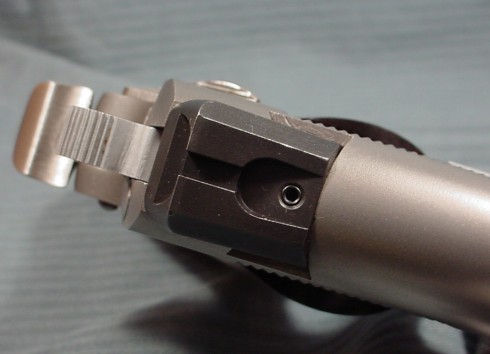 There was a time when if you wanted Novak sights you sent your pistol to a gunsmith and had the slide milled for them. Pistols simply didn't come with them standard.
There was a time when if you wanted Novak sights you sent your pistol to a gunsmith and had the slide milled for them. Pistols simply didn't come with them standard.
Did the user want a different mainspring housing, that's a change one can make at home. Did he get bit and need a wide or possibly upturned grip safety? Everyone's hands are different and some can shoot with the original grip safety without pain--though a wide grip safety adds comfort for everyone. In those days no frames were cut for a beavertail and that was a choice one didn't make willy-nilly, but it was a choice one needed to consider.
Did he need or just want what we used to call an ambidextrous thumb safety (now the push is to use the term bilateral, which is more accurate mechanically, but ambidextrous was explicit in making clear that an off-side lever was a benefit to southpaws). Some left-handers over the decades learned slick ways to use the single-sided safety, but it seems to me the bilateral type is ideal. What I think would be more ideal is a new design that loses the lever on the left side of the pistol so lefties only have a lever on the right side of the gun--their strong side. One can train for using the pistol offhand and working the safety in a more awkward manner in a rare emergency (strong hand or arm disabled), but the majority of the time having an extra lever on one's offside is an annoyance.
~~I have purchased a couple 1911s with features I otherwise desired, and one first thing I do upon initial tear-down is to replace the unwanted bilateral safety with a strong side-only type. I realize that it doesn't matter for some guns that may be range toys only and will never see a holster or your tender skin worn all day concealed, but as my self-defense pistols are 1911s, it also behooves me to set up all my 1911s pretty much the same way.~~
Did our buyer want his slide's ejection port lowered or even flared (like a Gold Cup, popular in the day)? Lowering the ejection port is done seemingly automatically now, but it needn't be that way. You'll read or hear that it's to increase reliability, but no, not really, and only in a very very marginal way. Lowering the ejection port on the slide does one thing well--it prevents your brass from getting beat up on the way out, thus preserving it for reloading. This is important to reloaders and so became a common customizing feature--but not everyone reloads, and lowering the slide also opens the gun to debris, making this somewhat less desirable if one carries gun the gun, either exposed to weather or exposed to the detritus of concealed carry. In those days you could decide for yourself, these days you really can't.
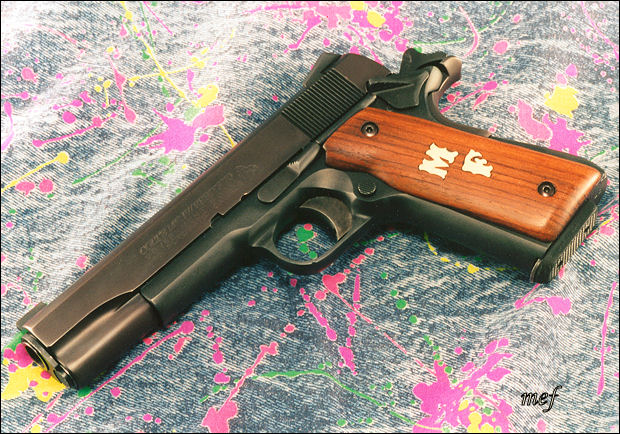 Early Colt which required customizing, although mostly in reliability work
Early Colt which required customizing, although mostly in reliability work
Serration, checkering, or any other surface changes to the steel or aluminum in order to enhance one's grip on the frame were available because the pistols of the day came with nothing whatsoever. There was always lots of discussion on the type of work, what style of checkering, how many lines-per-inch, and so forth were best, so our buyer could often make an informed decision with his gunsmith. Serrating or checkering the top strap of the slide was often requested to cut glare or simply look good. And of course the number of gunsmiths working on 1911s was huge in those days compared to now. The numbers doing high-end custom work may seem many, but I'm talking about day-in/day-out basic stuff, because everyone who bought a new 1911 pistol almost all of them Colts, was going to a pistolsmith for something in those days.
Trigger work was foundational. To say Colt triggers were poor is an understatement. So not only did one choose his trigger length, long or short (occasionally medium but that was rare), smooth or serrated and so forth, actual trigger work, the stoning of the hammer and sear, fitting of disconnector and sear spring, fitting and smoothing of the trigger bar--all that was required and it was critical. Today we can almost take for granted the very decent triggers will come with a new 1911, thanks in part to CNC machining, and that is a plus for today's guns.
~~Today's factory 1911s almost always come with trigger pull weights that are better for target shooting than self-defense. Anyone who has ever held someone at gunpoint with a 1911 must have perfect thumb safety and trigger discipline as that is all that holds you from a tragic accident or murder. Violent confrontations are not all respond and shoot. Especially in the home you may confront someone and circumstances *may* result in you holding a criminal for police. Do not think this cannot happen to you, and do not think for a minute that you will not be subject to the physiological impact of such an event. If your finger strays to the trigger, or your thumb goes hard on that safety once that criminal has surrendered, it's murder. (Hello Glock, where is your thumb safety again?) Lightweight defensive triggers are not for the untrained.~~
We also used to request smoothing of the pistol externally. It was gunsmith Jim Clark who originated the term melt job, which most people know, but long before that we used to call it dehorning or simply removing the sharp edges--a much milder form of external smoothing than a full-on melt job. Magwell edge beveling was a common request as well.
Those things were basics. There were many other options of course, full-length guide rods, controversial for a long time, extended slide locks (stupid), add-on mag-wells, "ambi safeties" to be added as these were never seen from the factory, etc. Some features common today hadn't been conceived of yet--undercutting the rear of the triggerguard, adding rails, forward serrations (ugh).
As the "factory custom" (no longer custom at all of course) became a standard for 1911s, thanks to Kimber, makers and gunsmiths both began to think outside the box for ways to add even more options to pistols, so good, some not so good, some neutral. Today if you want an existing feature you can probably find it and buy it with the only limiting factor being money. Without that limitation of course you can have anything you want, but that was always true--limited only by what we could imagine in the old days--we didn't have the plethora of night sights, etc etc.
Boiled down, prior to Kimber setting the scene for the "factory custom" that is now "factory standard," a buyer bought a bare-bones 1911 with no features much beyond what today's buyer thinks of as "GI," then after the purchase set about adding to the new pistol those things he thought was needed to make the pistol suitable for his use. Today one buys a pistol with every feature already in place, though sometimes it may be missing a particular feature he'd like or may have an extra feature he'd rather not have. With every possible option available today, one literally pays his money and takes his choice.
So who had it better? Is there really any question? Today's buyer, of course. But it isn't because of selection or because there is no longer a need for a gunsmith. Those things are both good most of the time for most of the people, both new 1911 buyers and long time 1911 people who know what they want. This is because most people are pretty accepting of what the marketplace offers and willing to select something on the menu. If there are thirty flavors available today, most people will be happy to choose one of those thirty flavors. But if you are one of the few who really miss vanilla, it's hard to find a satisfactory 1911 today without very deep pockets. Sadly, I find myself in that group.
What do I mean? I mean 1911 guys who know exactly what they want and are not particularly willing to compromise. Friends of mine who are equally enthusiastic about 1911s and equally knowledgeable and specific in their tastes differ slightly from me in that they are more likely to compromise--moderately--by accepting certain seemingly unavoidable popular features. Those of us who are perhaps too exacting in our tastes refuse to allow certain features into our collection of 1911s. For me, I won't buy a 1911 with forward slide serrations, as they cannot be removed of course, and I neither use them nor find them attractive. Other features I dislike but which I can change I will change, as I mentioned previously in the first colored sidebar. So if it is something I can change it isn't a deterrent to purchase. And it's less hassle and less money than engaging a gunsmith like the old days. Despite my lame "vanilla" analogy above, I do want a good sights, a good trigger, and a smooth pistol (thank-you Jeff Cooper), but I don't want nor need an excess of bells and whistles. But this is a distraction from the question as to why today's buyer has it better.
The real reason why today's 1911 pistol buying is better is because today's 1911 pistols are far better made than commercial pistols made in the last century. Today we have CNC machining for finishing of slides and frames and most parts. During the last century some companies were actually putting out 1911s that didn't even use the proper blueprints, pin holes in frames were improperly located, and parts fit was a joke. Even the grand old Colt Firearms of the mid-to-late 1900s--who did have the proper blueprints--were unreliable right out of the box. You had to break them in with ball ammo and even then you'd have malfunctions routinely, with FMJ ammunition.
To be fair a large part of the problem in those days came from the fact that 1911 magazines were, as a whole, atrocious. Every semi-auto pistol user knows magazines are integral to pistol reliability and perhaps even more so with an old design like the 1911 which does not feature inline feed like some modern designs. There were many brands of mags in the 20th Century but most of them were unreliable. Bill Wilson got famous early on as a 1911 pistolsmith, but probably most people know him for his excellent 1911 magazines. He certainly made a difference in that field--one of the only decent ones from that era.
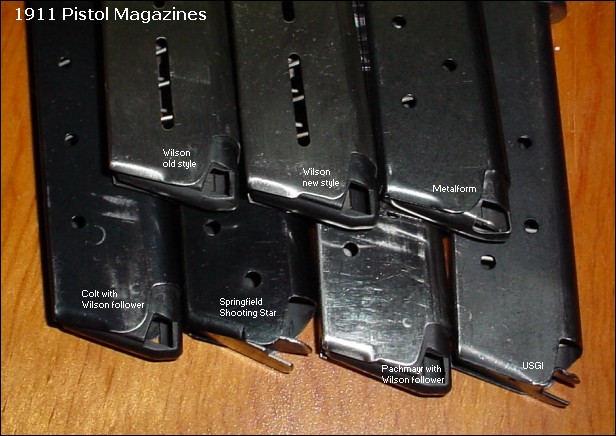
A selection of working 1911 magazines
The 1911 market today is not only the best it has ever been, with fine quality guns available from every almost large company in the industry, Colt itself has come back from a rough time in the late 20th Century and is making excellent 1911 pistols today as well. If you know a little bit about what you want, shopping around today should be half the fun of getting into the 1911 world. Even I never buy the first 1911 I run across when I want to add another to my collection. Thanks to the Internet and the manufacturer's presence, I can see what they make today, and find just what I'm looking for that next 1911, be it a 10mm, a compact, a target model for shredding bullseyes, or another carry gun. It's a 1911 world.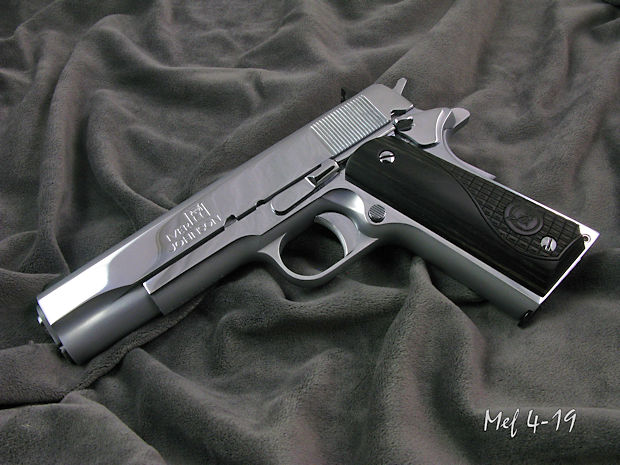
Iver Johnson hard chromed 1911

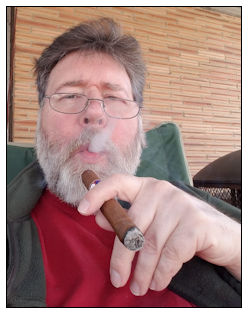
markfreburg
Uploaded: 8/21/2019

